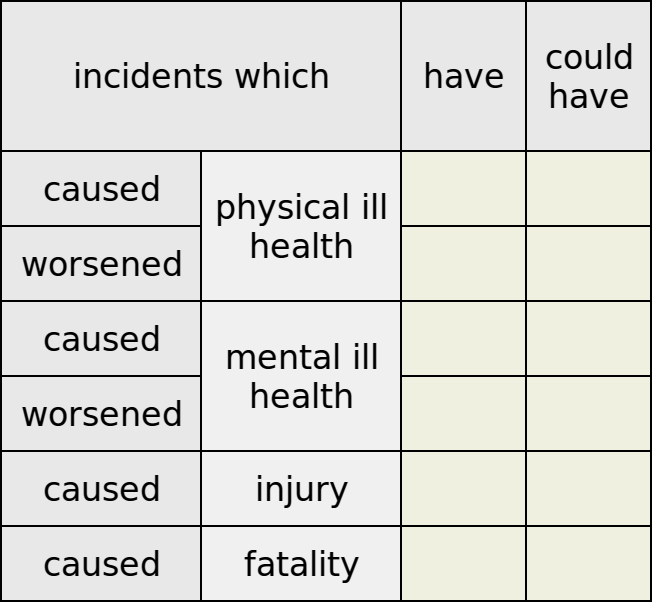These incident catecories are based on definition 3.8 and 3.9 in OHSAS 18001:2007. The data should be easy to obtain. Just quarterly categorize OH&S incidents using the twelve categories shown below. Then count the incidents per category and enter the sums for each category into the table.
 In words:
In words:
Incidents which …
1.1.1.1 … have caused physical ill health
1.1.1.2 … have worsened physical ill health
1.1.2.1 … could have caused physical ill health
1.1.2.2 … could have worsened physical ill health
1.2.1.1 … have caused mental ill health
1.2.1.2 … have worsened mental ill health
1.2.2.1 … could have caused mental ill health
1.2.2.2 … could have worsened mental ill health
2._.1._ … have caused injury
2._.2._ … could have caused injury
3._.1._ … have caused fatality
3._.2._ … could have caused fatality
Or in other words (even closer to OHSAS 18001:2007):
Incidents in which …
1.1.1.1 … physical ill health occurred
1.1.1.2 … physical ill health worsened
1.1.2.1 … physical ill health could have occurred
1.1.2.2 … physical ill health could have worsened
1.2.1.1 … mental ill health occurred
1.2.1.2 … mental ill health worsened
1.2.2.1 … mental ill health could have occurred
1.2.2.2 … mental ill health could have worsened
2._.1._ … injury occurred
2._.2._ … injury could have occurred
3._.1._ … fatality occurred
3._.2._ … fatality could have occurred
“Incident” and “ill health” according to OHSAS 18001:
The underlined words met resistance from employers when moving from OHSAS 18001:1999 to OHSAS 18001:2007. In internal communications they tried to replace “ill health” by “desease” and “identifiable” by “diagnosable”. They also tried to hide “regardless of severity” from their employees. “Made worse” was not welcome, as the term did not allow them to reject incidents which worsened an already existing ill health. And “could” was a challenge to employers, because due to that term they could not ask affected employees to prove that they actually suffered from ill health. The reasons for resisting against “mental” where quite similar to the reasons for mentioning “psychological factors” only in the notes to clause 7.1.4 of ISO 9000:2015 rather than clearly in the clause itself.
Discussion:
Download:
